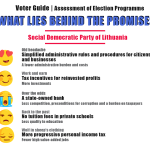On October 11, Lithuania will hold parliamentary elections. A total of 141 representatives of the nation will be elected, of which 71 in single-mandate constituencies and 70 from party lists.
According to the latest opinion polls, the Lithuanian Farmers and Greens Union and Homeland Union – Lithuanian Christian Democrats have the biggest voter support, standing at 17.6% and 17.2% respectively. Three other parties seem to be likely to cross the 5% threshold to get representation in parliament.
The Lithuanian Social Democratic Party now enjoys 8.5% of the voter support, the Labor Party 8.4%, and the Liberal Movement, 5.5%. Other parties do not seem to have chances of pulling through.
The Lithuanian Farmers and Greens Union, now a ruling party, is seeking re-election. However, this party does not have its own genuine election program, which is quite uncommon in Lithuania.
As their programmatic documents they name the strategic state development documents, such as the National Progress Plan for 2021–2030, the DNA Plan for the Future Economy of Lithuania and the National Action Plan for Energy and Climate for 2021–2030.
Farmers and Greens prioritize culture, want to give more attention to regions and attract investment there. They also seek to increase family allowances, especially child benefits, establish a 13th pension to retirees before Christmas and free undergraduate studies for all students. Expanding the state apparatus and establishing a state commercial bank are also among their priorities.
The biggest opposition party in Lithuania is Homeland Union – Lithuanian Christian Democrats, or popularly called the Conservatives. Their promise is to cut down on the number of laws, allowing more time for debates and better impact assessment.
The Conservatives are seeking to create incentives to keep older people in the labour market by improving the tax environment and working conditions. Also, the party wants to create a convenient accounting and tax payment platform for small and medium-sized enterprises.
Unlike Farmers and Greens, the Conservatives suggest focusing state aid on top 10 economic centers of Lithuania, providing a separate growth plan for each of them and appropriate financing through subsidies. The party also suggests linking university degree funding to a forecasted future demand.
The third most popular party are the Lithuanian Social Democrats. This party has been in opposition for the last three years. Nevertheless, political analysts predict a big win for them in the second round of the elections as the second best option for some voters. The party proposes corporate tax exemptions for reinvested profits and a more progressive personal income tax, it seems to be committed to simplifying administrative rules and procedures for citizens and businesses.
Other promises are to reform the public procurement system, to establish a state development bank, and to ban tuition fees in private schools.
The Liberal Movement is emphasizing the need for a more efficient and targeted social assistance, increasing the tax exempt income to help the lowest income earners, and a healthcare financing reform. However, a promise of raising the state debt limit to 60 percent sounds like a wolf in sheep’s clothing.
A blended election system makes it hard to predict winners. Even if the COnservatives and Farmers and Greens get a majority after the first round, everything can change in the second round when people choose between the two remaining candidates.
Find out more at: https://www.delfi.lt/ [in Lithuanian]







